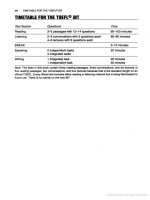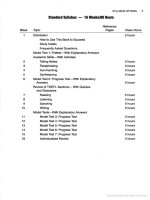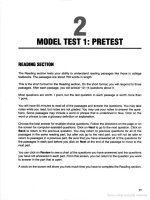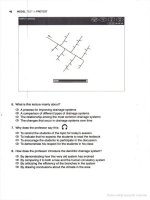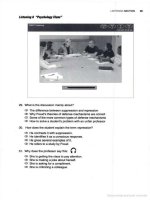Toefl ibt internet based test 2006 - 2007 part 24 ppsx
Bạn đang xem bản rút gọn của tài liệu. Xem và tải ngay bản đầy đủ của tài liệu tại đây (778.44 KB, 7 trang )
READING
SECTION
,
55
-+
Western selllement and the opening
oIlhe
northern resource frontier stim-
ulated industrial expansion, particularty in
C811tral
Canada. As the National Pol-
icy had intended, a growing agricultural population in
the
West increased
the
demand lor eastern manufactured goods, thereby giving
rise
to agricultural
implements
worM
, iron and
steelloundries
, machine
shops
, railway yards, tex-
tile mills,
boot and shoe factOries, and numerous smaller manufacturing
ef1te
r-
prises that suppli
ed
consumer
goods.
~
~
~
" -
;:'':':1.
L
_
To
climb the tariff wall, large American industrial
firms
opened
branches in Canada, and
the
governments
01
Ontario
and
Quebec
aggreSSively
urged
by
offering bonuses, subsidies, and guarantees to locate
new
plants within their borders. canadian industrial enterprises became increas-
ingly attractive to foreign Investors, especially from the United States
and
Great
Britain.
Much
01
the over $600 million
of
American capital
that
flowed into
Canada
from
19CN)
to 1913 was
earmamKI
for
mining and the pulp and paper
industry, while British investors conlributed near $1.8 billion, mostly in railway
building,
business development, and
the
construction
01
ulban
infrastructure.
As a result, the gross value
of
Canadian manufactured
prcx:lUCIS
quadrupled
from
189110 1916.
1.
Why
does
the
author meotion
the
railroads in paragraph I?
<D Because miners were traveling
10
camps in
the
west
<D Because minerai
deposits
were discover-ed when the railroads were built
<D
Because the western frontier
was
being sellied
by
families
<D
Because traders used the railroads to transport their goods
Paragraph
1 is marked with an arrow (
-+
].
2. In paragraph I, the author identifies Sudbury as
<D
an important stop
on
the
new
railroad line
<D
e large mar1tetlor
the
metals produced
in
Ontario
<D a major industrial
C811ter
lor
the
production
01
nickel
CD
a mining town in the Klondike region
Paragraph
1 is marked with an
arrow
(-+].
3.
The
word
eobaoce
in
!he
passage
is
closest
in
mean
i
og
to
<D disrupt
<D
restore
<D
identify
<D improve
150 MODEL T
ES
T 2: PROGRESS TEST
4, According to paragraph 2, why
wa
s the Yukon Territory Cl'eated?
G>
To
encourage people to settle
the
region
<D
To
prevent Alaska fr
om
acquiring it
<D
To
establish law and
order
in
the area
G>
To
legalize the mining
claims
Paragraph 2
is
marlted wi
th
an arrow [-+
J.
5.
The word oravjously in the
pa
ssage
is
closest in meaning to
G> frequently
$ suddenly
<D routinely
a>
formerly
6.
How
did the poetry by
RODert
Service contribute
to
the development
of
Cana<la?
CD
It made the Klondike gold rush famous.
<D
It encouraged families
to
settle
in
the Klondike.
<D
It
captured the beauty
of
the western Klondike.
G> It
~evented
the Klondike's annexation to Alaska.
7. According to paragraph 3, the f
ore
st industry supported the development of Canada in all
of
the following ways
EXCEPT
G> by supplying wood
for
the construction
of
homes
and buildings
<D
by clearing the land for expanded agricultural uses
<D by
~oduc
i
ng
the
power
for the hydroelectric plants
$ by exporting
wood
and newsprint to foreign marltets
Paragraph 3 is marlted
with
an arrow [-+
].
8. The
word
Furthermore in
the
passage
is
closest
in
meaning to
CD
Although
<D Because
<D
Therefore
(Jtl
Moreover
~
bask tlet matenale
READING
SECTION
151
9.
Which
01
the
sentences
below
best
exp!"&Sses
the
Information in the highlighted statement
in
the
passage?
The
other
choices
change
the meaning
or
leave
out
important information.
<D
New
businesses and Industries
were
created
by
the
federal
government
to
keep the
prices
of
manufactured
goods
low.
«>
The
lower
price
01
manufacturing attracted
many
foreign businesses and
new
Ind
us
-
tries
to
the
area.
<D
Federal
was
on
cheaper
impo
rt
ed
goods
were responsible for protecting domestic
industries
and
supporting
new
businesses.
~
The fedefal
tax
laws
made
it difficult
for
manufacturers
to
sell their
goods
to
foreign
mattets.
10.
The
word
1bmn
in the
passage
refers to
<D
govemments
<J)
plants
<D firms
G)
policies
11.
According to paragraph 4, British and American bUSinesses
opened
affiliat
es
in
Canada
"""','"
a:>
the
Canadian
government
offered Incentives
<J)
the raw materials
were
available In
Canada
<D the consumers in
Canada
were
eager
to
buy
their
goods
en>
the
infrastructure
was
attractive
to
invesl
OfS
Paragraph 4 is
matted
wi
th
an
arrow [-+
[.
12. Look
al\he
four SQuares , _ [ that
show
where
the
following sentence could be inserted in
the passage.
Railway construction through
the
Kootenay region
of
southeastern British
Colum
-
bia
also
led to significant
discov
eries
of
gold,
Illver
,
cOP9Qr
, lead, snd zinc.
Where could
the
sentence
bes
l be added?
Click
on
a square (- 1
to
insert
the sentence in
the
passage.
~
bask tlet materl3le
1
58
MODEL
TE
ST 2:
PROGRESS
TE
ST
13. Di
rec
ti
ons:
An
introdlJClion for a short summary of the passage appears below. Complete
the summary by selecting
the
THREE answer choices that ITl9fltion the most Important
points In the passage. Some sentences
do
not belong in the summary because they
express
Ideas that are
nol
included in the passage or are minor points from the passage.
Th
is question is
worth
2
points
.
The
northern
frontier
provided
msny
natural
resouren
that
contributed
to
Indu
s-
trial
expan
a
lon
of
Canada.
•
•
•
An
s
wer
Choice
s
!!I
The
Yukon Territory was created in 1898
during
the gold rush
In
the Klondike and
Yukon River valleys.
!SJ
The frontier was documented in the
p0p-
ular press, which published tales of
heroes and
gold strikes.
!Cl
Signilicant discoveri
es
of mineral
deposits encouraged prospectors and
senters
10
move into the territories.
PART
II
1INd1", 2
"1MIr/",.t
1lIutJ.
JI&ttKJ
"
IDl
Wheat and other agricultural crops were
planted after the forests were cleared,
creating
the central plains.
lEI
Powered by hydroelectricity.
lumbef
and
paper mills exploited the forests for both
domestic and foreign markets.
lEI
Incentives encouraged American and
British Investors to help expand manu-
facturing
plants in Canada.
-+
One Greek theatre
Is
through arche-
ology,
such as architecture, inscriptions,
sculpture, vase
painting, and other loons
01
decorative art.
fAJ
Serklus
on-site
excavations
began in Greece around 1870,
but
W.
DOrpfeld did not begin the
first extenSive study of
the
Theatre of Oionysus until 1886
.1!l
Since that time,
more
than 167 other Greek theatres have been identified
and
many
01
them
have been excavated.
ICl
Nevertheless, they still do
not
permit us
10
describe
bas tlet
mat
na
READING
SECTION
151
",pe'~""
of the skene
(i
llustrations printed in books are conjec-
reconstructions), since
many pieces are irrevocably lost because the
buildings in later periods became sources
01
stone lor other projects
and
what
remains is usually broken
and
scattered.
[DJ
That most
01
the buildings
were
remodeled
many
limes
has
created great problemS lor those seeking
to
date
both
the paris
and
the sll"X'm'sive versions. Despite these drawbacks, archeol-
ogy provides
the
most concrete evidence
we
!\ave about the theatre structures
01
ancient Greece.
But.
if they
heve
told
us
much
, archeologists !\ave not com-
pleted their
worX,
and
many sites !\ave scarcely
been
touched.
-+
Perhaps the use
01
archeological evidence in theatre
history is vase paintings, thousands
01
wh
ich have survived from ancient
Greeoe. (Most 0I1hose used
by
theatre scholars are repmduced
in
Margarete
Bieber's
The Histoty
of
ItJe
Greek
and
Roman
Theatre
.) Depicting
scenes
Irom
mythology
and
daily life, the vases are the most graphic pictorial evidence
we
have. But they are also easy
to
misinterpret.
Some
scholars have considered
any
vase that depicts a subject treated In a surviving drama or any scene show-
ing
masks
, flute players, or ceremonials
to
be
valid evidence
01
theatrical prac-
tice. This
Is
a highly questionable assumption, since the Greeks made
widespread
use
01
masks,
dances,
and
music outside the theatre
and
since
the
myths
on
wh
ich dramatists drew were known
to
everyone, including vase
pairlters,
who
might well depict
the
same
subjects
as
dramatists without being
indebted
to
them
. Those vases showing scenes unquestionably theatrical
are
lew
in
number.
-+
Written
eviclenoe
about ancient Greek theatre is often treated
as
less
reli-
able than archeological evidence because
most
written accounts
are
separated
so lar in lime from the events they describe
and
because they provide no irllor-
mation about their own sources. Of the written evidellCe,
the
surviving
plays
are
usually treated as the most reliable. But the oldest surviving manuscripts of
Greek
plays date
from
around
the
tenth century, C.E.,
some
1500
years
after
they were lirst perlormed. Since printing did not exist during this lime span,
copies
01
plays
had
to
be
made
by
hand
, and therefore
the
possibility
01
textual
errors
aeeping
in
was
magnified. Nevertheless, the scripts offer
us
our readiest
access
to
the cultural
and
theatrical conditions
out
01
which they
came
.
But
these scripts, like other kinds
01
evidence,
are
subject
to
varying Interpretations.
Certainly
perlormances
embodied
a male perspective, lor example, since the
plays
were
written, selected, staged,
and
acted
by
men.
yet the
exiSting
plays
leature numerous choruses
01
women
and
many leature strong lemale charac-
ters. Because these characters often
seem
victims
01
their
own
powerlessness
and
appear
to
be
governed, especially in the comedies,
by
se:cuat
desire, some
critics have seen these plays as ralionalizatiorls
by
the
maIe-Oominated
culture
lor
keeping women segregated and cloistered. Other critics, howeV9f, have
seen
in these
same
plays
an
attempt
by
male authors to lorce their male audi-
ences
to
e:cam
i
ne
and
call into question this segregation
and
cloistering
01
Athenian
women
.
160
MODEL
TEST
2:
PA
OO
AESS
TEST
~
By far Ihe majOrity
of
written ref&rences
10
Greek theatre date from several
hundred years after the events they report. The writers seldom mention their
sources of evidence,
and
thus
we
do
no
t know what credence to give
MW.
In
the absence of material nearer in time
10
the events, however, historians have
used the accounts and have been grateful to have them. Overall, historical
treatment of the Greek theatre
Is
something like assembling a Jigsaw puzzle
from which many pieces are missing: historians arrange what they have and
imagine (with the aid of
the
remaining evidence and logic) what has been Iosl.
As a result, though the broad oullines
of
Greek theatra history are reasooably
clear, many
of the details remain open 10 doubt.
Glossary
skene: a
stage
building
where
actors
store their ma
sks
and change
their
costumes
14. According to paragraph 1, why is it impossible to identify the time
periOO
f()( theatres in
Greece?
<D There are too few sites that have been excavated
and
very little data collected about
them.
<1>
The archeologists
from
eariier periods
were
not careful, and
many
artifacts were
broken.
¢)
It
is confusing because stones from early sites were used
10
build later structures.
<D Because it is very difficult
to
date the concrete that was used in construction during
earty
periOOs.
Paragraph t is marked with an arrow
[
~I
.
15
. What can
be
inferred from paragraph 1
aboutlhe
fJk_ln
Iheatre history?
<D Drawings in books are the only accurate visual records.
<D
Not enough evidence is available to make a precise model.
¢)
A1chaeologists have excavated a large number ol lhem.
(I)
It
was not identified
or
studied
unlilthe
early
lBOOs.
Paragraph 1 Is marked wilh an arrow
I
~
l
.
16. The word orima()l in the passage is closest in meaning to
® reliable
<I>
important
«> unusual
<D accepted
17. The word precise in the passage is closest
in
meaning to
<D
attractive
<I>
simple
¢)
dilliCuh
(I)
exact
~
bask ttel matarlala
READING
SECTION
161
18. In paragraph 2.
the
authOr explains that all vases with paintings of masks
or
mus
icians
may not
be
evidence of theatrical subjects by
<I>
arguing that
the
subjects
could
nave been used by artists without reference to a drama
CD
Identifying some of the vases as reproductions that were painted years after the
originals
CD
casting doubt
on
the
qualifications of
the
scholars
who
produced the vases
as
.""""'"
$ pointing out that there are very few vases that have survived from the time of earty
de""""
Paragraph 2 is marked with
an
arrow [
-+
J.
19. The
word
ooolroyersial in the passage is closest in meaning to
<I>
accepted
CD
debated
CD
limited
$ complicated
20
.
In
paragraph 3, the author states that lemale characters in Greek theatre
<I>
had
no
featured parts in plays
CD
were mostly ignored
by
critics
CD
did not partiCipate in the
chorus
G)
frequently played
the
part
of
victims
Paragraph
3 is marked with
an
arrow [
-+
].
21. According
to
paragraph 3, scripts of plays
may
not
be
accurate because
(l)
the sources cited are not welt known
CD
copies
by
hand
may
oontain many errors
CD
they are written in very old language
G)
the printing is dilflCUtt to fead
Paragraph
3 is marked with an
arrow
[
-+
1.
22. The
word
1bem
in the passage refers to
""
,
CD
sources
CD
writers
<lD
references
23. Why
does
the
author
mentiOn a jigsaw
puzzle
In
paragraph 4?
<I>
To
demonstrate the dilflCUlty in drawing conclusions from partial evidence
CD
To
oompare the written felerences
lor
plays
to
the
paintings
on
vases
CD
To
justify using acoounts and f'9(X)fds that historians have located
<lD
To
introduce the topic for the next reading passage in the textbook
Paragraph 4 is
mar1I:ed
with an
arrow
1-+1.

